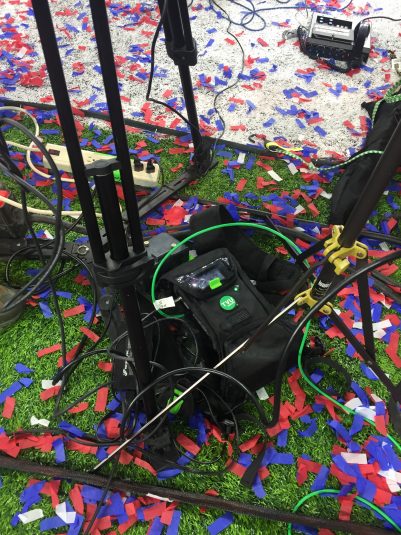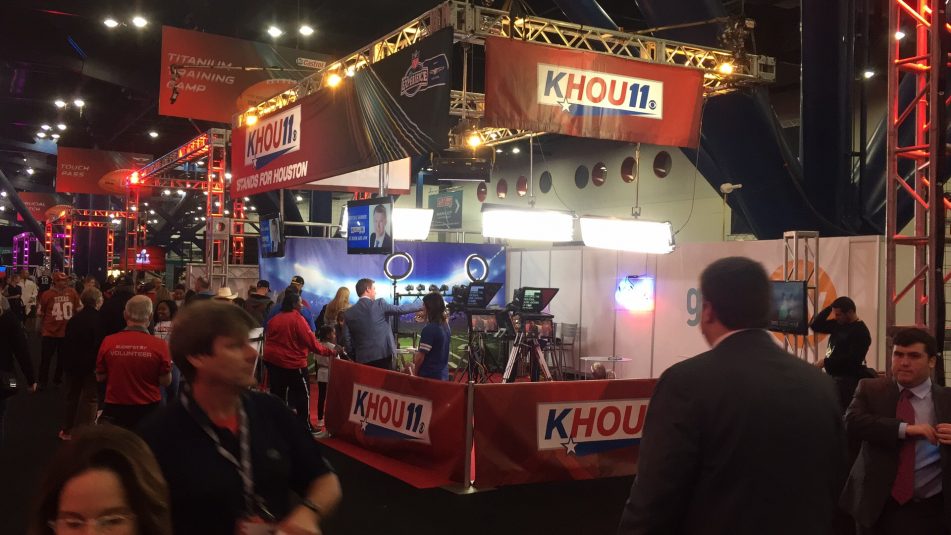Super Bowl LI: Local Stations, ESPN Embrace TVU Networks for Live Transmission Needs
Technology enables delivery via Ethernet or bonded cellular
Story Highlights
TVU Networks had a big presence during Super Bowl Week in Houston, with approximately 20 local TV stations as well as ESPN and ESPN International deploying its latest video- and audio-transmission technology, which allows delivery via Ethernet for those who spend much of their time at a primarily fixed location and via bonded cellular for those on the move.
“All of our equipment performed like champs,” says Chris Bell, VP, customer support and technical operations, TVU Networks. “Many people relied on fixed Ethernet for positions they knew they’d remain at for a while. We also had a Dallas station doing a live shot from an open-top bus in Houston, and they were thrilled with how that turned out. And we had one TVU transmitter on the field postgame running purely on cellular service, which in theory is a no-no but worked beautifully.”

TVU One allowed local stations to transmit live from the field following the Patriots’ stunning victory at Super Bowl LI.
Other stations that relied on TVU included WAGA Atlanta; WXIA Atlanta; KHOU Houston; WCSH Portland, ME; and KARE Minneapolis.
“Multimedia journalists from Austin, San Antonio, and Beaumont, TX, were also there,” Bell says, “and we had customers from all station groups represented, including TEGNA Media, NBC, ABC, and Fox affiliates.”
The Super Bowl is a congested RF environment that requires a lot of signal coordination to ensure that traditional RF-transmission needs are met. The TVU One system avoids that congested spectrum but still faces some challenges as the use of cellular devices among average consumers at major sports events becomes the norm.
“Yes, the environment can be congested, but, with our improved software and new TVU One antenna design, our systems performed marvelously and consistently delivered high-quality video,” Bell reports. “After the Patriots won the game, our systems went live from the field at NRG Stadium without a hitch. Just as Tom Brady was receiving the Super Bowl trophy and 70,000 fans were sending video live to Facebook, our portable transmitters did their thing. Some [were] reliant on purely cellular, but they all worked great.”
Freed from the constraints of RF-signal coordination, users of bonded-cellular transmission have the freedom to change plans without needing to contact a coordinator or, even worse, being told transmission is impossible.
“You can run on to the field and go live, and you can walk into a locker room and go live,” says Bell. “Folks from ESPN were walking around the stadium and speaking to fans going into the stadium before the game. You can’t do anything like that in any other way. Journalists can be fast moving and adapt to whatever situation they find themselves in and there are no constraints from the hardware in terms of what you can and can’t do.”
Historically, one of the difficulties using a system that relied on bonded cellular has been the massive burden on the cellular-transmission bandwidth as fans fire up their phones. A test transmission that goes perfectly well in an empty stadium the day before the big game can struggle when the stadium is full. But that occurrence is becoming less and less prevalent for TVU One users.
“One fundamental thing about the equipment is that, if you’re experiencing interference or any connection issues with one carrier, our system adapts to it and pushes it on to another route,” says Bell “So, in crowded places like the Super Bowl, we’re in good shape.”
And KHOU Houston even used the system to provide backhaul from the Super Bowl Experience at the George R. Brown Convention Center. Every day during Super Bowl Week, the station transmitted live from a studio within the Experience.
“They had a TVU system plugged into an Ethernet backhaul and used TVU as their transmission pipeline for the duration of their coverage,” says Bell. “TVU One served as their stable transmission path to their home studio, and this is a trend we see a lot of our customers taking advantage of lately.”

